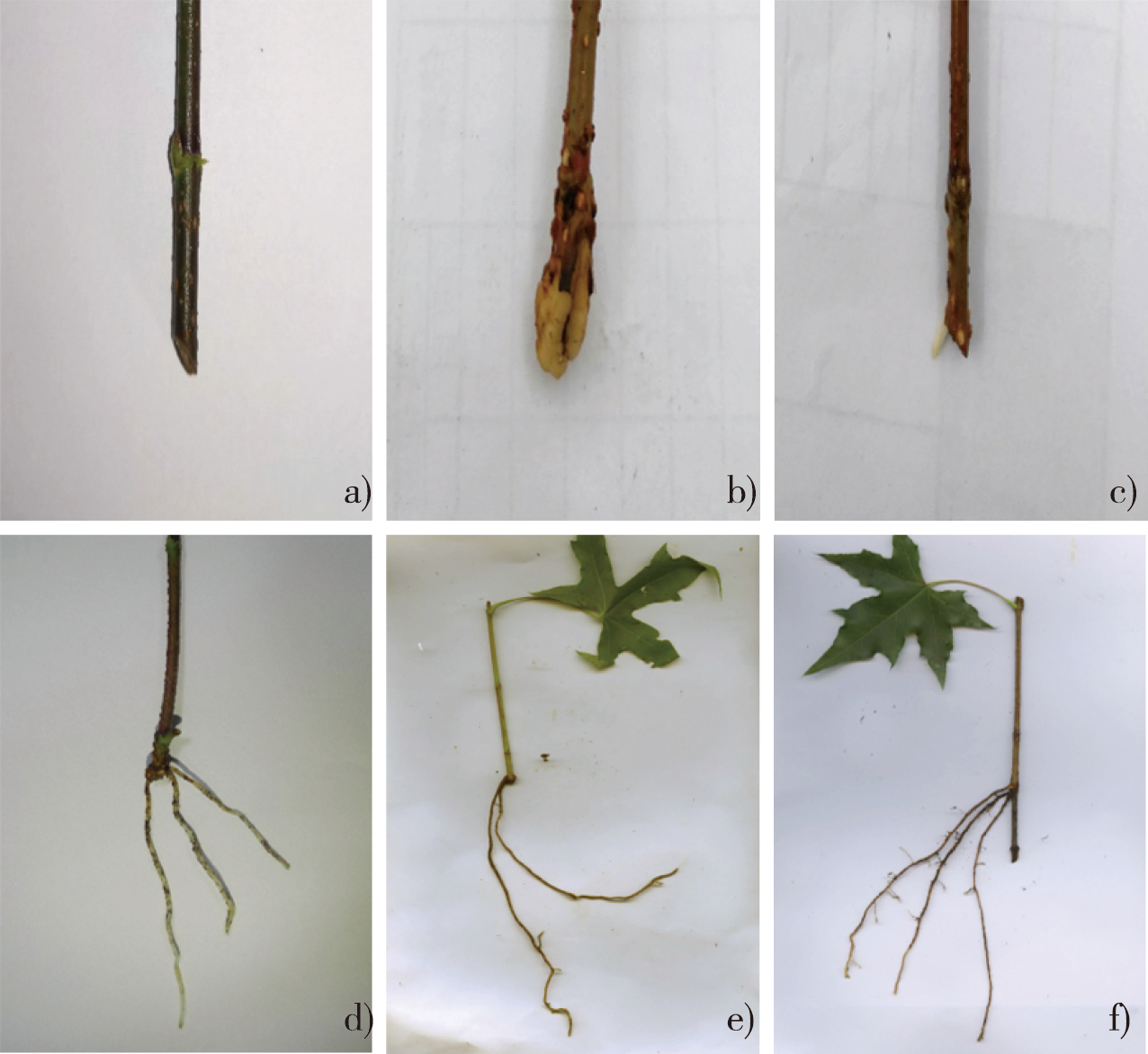 PDF(1786 KB)
PDF(1786 KB)


Softwood cutting technology for Acer truncatum and physiological and biochemical analysis during rooting process
WANG Yuxiao, ZHANG Bin, MA Qiuyue, FU Wei, KANG Zhen, ZHU Changhong, LI Shuxian
Journal of Nanjing Forestry University (Natural Sciences Edition) ›› 2024, Vol. 48 ›› Issue (5) : 123-130.
 PDF(1786 KB)
PDF(1786 KB)
 PDF(1786 KB)
PDF(1786 KB)
Softwood cutting technology for Acer truncatum and physiological and biochemical analysis during rooting process
【Objective】 In order to investigate the effects of different treatments on the rooting of softwood cuttings of Acer truncatum and find the best treatment method. We analyzed the relationship between changes in nutrient content, oxidase activity, and rooting of cuttings, and preliminarily explored the rooting mechanism of A. truncatum. 【Method】 Using rejuvenated A. truncatum trees and three-year-old A. truncatum mother trees as study materials, we conducted an analysis of the effects of growth regulators [indole-3-butyric acid (IBA) and 1-naphthaleneacetic acid (NAA) and a rooting solution], cutting positions (upper and lower parts), rejuvenation, and cutting time (June and September) on the rooting of A. truncatum. Furthermore, we examined the rate of root growth, callus formation, number of roots, root length, and other indicators of root development. Additionally, changes in nutrient contents (soluble sugar and soluble protein) and changes in oxidase activity [peroxidase (POD), polyphenol oxidase (PPO), and indole-3-acetic acid oxidase (IAAO)] were measured during the rooting process. 【Result】 The optimum IBA and NAA concentrations were 500 and 800 mg/L respectively, and the rooting rates were 59.3% and 52.7%, respectively. The optimal concentration for the rooting solution was a 1.43% volume fraction (70-fold) dilution, which achieved a rooting rate of 43.9%. Significant differences were observed among the three treatments, with all rooting indexes of cuttings treated with growth regulators performed better than those of the control. Additionally, the rooting effect of cuttings in June was better than that in September; the rooting effect of rejuvenated mother trees was better than that of 3-year-old trees; and the rooting effect of upper cuttings was better than that of lower cuttings. There were substantial differences observed following these treatments. During the rooting of the cuttings, the changes in the soluble sugar content following the treatment displayed a decreasing trend followed by an increasing trend. The soluble protein content, POD activity, and PPO activity initially increased and then decreased. However, the IAAO activity displayed a trend of decrease-increase-decrease. The control group exhibited a similar changing trend to that of the treatment group, but the peak time for the treatment group was 5-10 days earlier than that of the control. 【Conclusion】 The adventitious root formation of A. truncatum was categorized as a mixed rooting type. When the upper cuttings of rejuvenated mother trees were treated with IBA 500 mg/L, all rooting indexes were optimized, and the rooting rate peaked at 81.3%. Growth regulator treatment can improve the metabolism rate of nutrients and the synthesis process of related oxidase, and has a facilitative effect on the rooting of cuttings.

Acer truncatum / growth regulator / softwood cutting / nutrient / oxidase
| [1] |
傅立国. 中国高等植物-第七卷[M]. 青岛: 青岛出版社, 2001.
|
| [2] |
李悦, 蔡亚南, 任安琦, 等. 盐碱胁迫对元宝枫幼苗生长和生理特性的影响[J]. 东北林业大学学报, 2022, 50(8): 5-14,21.
|
| [3] |
王琨, 刘少波, 张娜, 等. 元宝枫研究进展[J]. 西北林学院学报, 2021, 36(3): 152-157,280.
|
| [4] |
王性炎, 王妹清. 新资源食品:元宝枫籽油[J]. 中国油脂, 2011, 36(9):56-59.
|
| [5] |
马秋月, 王亚楠, 李淑顺, 等. 元宝枫种子发育过程中油脂积累与可溶性糖、蛋白质之间的关系[J]. 江苏农业学报, 2021, 37(4): 982-989.
|
| [6] |
|
| [7] |
谷荣辉. 中国乡土树种元宝枫的化学成分及代谢组学研究[D]. 北京: 中央民族大学, 2019.
|
| [8] |
张洪波. 元宝枫优树繁育技术研究[D]. 北京: 北京林业大学, 2016.
|
| [9] |
赵瑞, 沈永宝. 林木扦插繁殖研究进展[J]. 种子, 2019, 38(9): 57-66.
|
| [10] |
李岱龙, 王文文, 王娟, 等. 一种元宝枫扦插育苗方法. CN105830708A[P]. 2016.
|
| [11] |
施雷, 张超. 一种元宝枫树扦插方法. CN105993802A[P]. 2016.
|
| [12] |
李合生. 植物生理生化实验原理和技术[M]. 北京: 高等教育出版社, 2000.
|
| [13] |
高俊凤. 植物生理学实验指导[M]. 北京: 高等教育出版社, 2006.
|
| [14] |
贾娟, 姚延寿, 史敏华, 等. 生根剂促进槭树植物扦插繁殖的研究进展[J]. 西北林学院学报, 2010, 25(4): 107-109,134.
|
| [15] |
郑巧巧, 兰思仁, 刘雪蝶, 等. 生长调节剂对‘香妃’含笑扦插生根及相关酶活性的影响[J]. 中南林业科技大学学报, 2020, 40(5): 67-76.
|
| [16] |
王艺, 贾忠奎, 马履一, 等. 4种植物生长调节剂对红花玉兰嫩枝扦插生根的影响[J]. 林业科学, 2019, 55(7): 35-45.
|
| [17] |
魏茂胜. 不同处理对茶绒杜鹃扦插生根与生长的影响[J]. 森林与环境学报, 2019, 39(1): 27-31.
|
| [18] |
魏黔春, 江泽平, 刘建锋, 等. 侧柏古树扦插试验及插穗营养物质变化[J]. 南京林业大学学报(自然科学版), 2020, 44(1): 63-71.
|
| [19] |
卜晓婷, 乔孝禄, 徐晓华, 等. 母树年龄、采穗时期和抑制物质对纳塔栎生根的影响[J]. 东北林业大学学报, 2022, 50(2): 11-16,28.
|
| [20] |
郑先波, 王昊, 谭彬, 等. 埋干幼化处理对榛扦插生根的影响[J]. 经济林研究, 2016, 34(2): 147-151.
|
| [21] |
袁利利. 华北五角枫扦插繁殖技术及生根机理的研究[D]. 泰安: 山东农业大学, 2012.
|
| [22] |
薛满满, 常雪薇, 李春明, 等. 美国白蜡嫩枝扦插生根特性[J]. 中南林业科技大学学报, 2022, 42(4): 40-48.
|
| [23] |
|
| [24] |
侯江涛, 沈聪聪, 张毅芳, 等. 植物扦插繁殖生根机理研究综述[J]. 安徽农业科学, 2019, 47(19): 1-3,6.
|
| [25] |
吕庚鑫, 孟益德, 庆军, 等. ‘华仲6号’杜仲嫩枝扦插生根的解剖及生理变化[J]. 林业科学, 2022, 58(2): 113-124.
|
| [26] |
|
| [27] |
|
| [28] |
梁玉堂, 龙庄如. 树木营养繁殖原理和技术[M]. 北京: 中国林业出版社, 1993.
|
| [29] |
乔孝禄, 卜晓婷, 徐晓华, 等. 纳塔栎嫩枝扦插生根过程中的生理变化[J]. 中南林业科技大学学报, 2021, 41(4): 86-92.
|
| [30] |
刘欢, 刘济明, 骆畅, 等. GGR-6对米槁插穗生根过程中生理动态的影响[J]. 东北林业大学学报, 2021, 49(10): 42-46,64.
|
| [31] |
|
| [32] |
|
| [33] |
凡莉莉, 薛磊, 赖金莉, 等. 大头典竹扦插过程中营养物质和氧化酶活性变化研究[J]. 竹子学报, 2018, 37(1): 54-59.
|
| [34] |
吴红, 陆辉, 高克利, 等. 生长调节剂对青钱柳扦插生根及生根过程中保护酶系统的影响[J]. 北方园艺, 2019(20): 106-111.
|
/
| 〈 |
|
〉 |